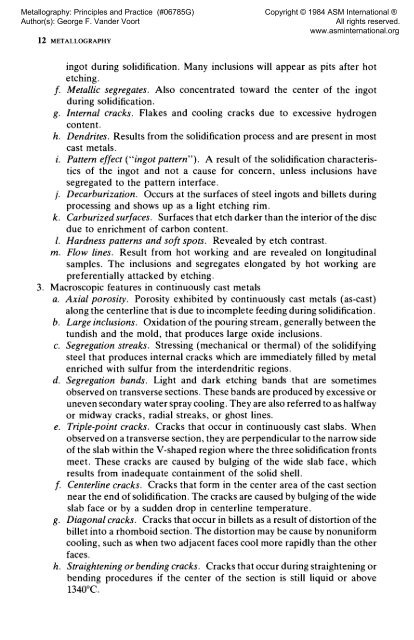Metallography: Principles and Practices - ASM International
Metallography: Principles and Practices - ASM International
Metallography: Principles and Practices - ASM International
Create successful ePaper yourself
Turn your PDF publications into a flip-book with our unique Google optimized e-Paper software.
<strong>Metallography</strong>: <strong>Principles</strong> <strong>and</strong> Practice (#06785G)<br />
Author(s): George F. V<strong>and</strong>er Voort<br />
12 METALLOGRAPHY<br />
Copyright © 1984 <strong>ASM</strong> <strong>International</strong> ®<br />
All rights reserved.<br />
www.asminternational.org<br />
ingot during solidification. Many inclusions will appear as pits after hot<br />
etching.<br />
/. Metallic segregates. Also concentrated toward the center of the ingot<br />
during solidification.<br />
g. Internal cracks. Flakes <strong>and</strong> cooling cracks due to excessive hydrogen<br />
content.<br />
h. Dendrites. Results from the solidification process <strong>and</strong> are present in most<br />
cast metals.<br />
/. Pattern effect {"ingot pattern"). A result of the solidification characteristics<br />
of the ingot <strong>and</strong> not a cause for concern, unless inclusions have<br />
segregated to the pattern interface.<br />
/. Decarburization. Occurs at the surfaces of steel ingots <strong>and</strong> billets during<br />
processing <strong>and</strong> shows up as a light etching rim.<br />
k. Carburized surfaces. Surfaces that etch darker than the interior of the disc<br />
due to enrichment of carbon content.<br />
/. Hardness patterns <strong>and</strong> soft spots. Revealed by etch contrast.<br />
m. Flow lines. Result from hot working <strong>and</strong> are revealed on longitudinal<br />
samples. The inclusions <strong>and</strong> segregates elongated by hot working are<br />
preferentially attacked by etching.<br />
3. Macroscopic features in continuously cast metals<br />
a. Axial porosity. Porosity exhibited by continuously cast metals (as-cast)<br />
along the centerline that is due to incomplete feeding during solidification.<br />
b. Large inclusions. Oxidation of the pouring stream, generally between the<br />
tundish <strong>and</strong> the mold, that produces large oxide inclusions.<br />
c. Segregation streaks. Stressing (mechanical or thermal) of the solidifying<br />
steel that produces internal cracks which are immediately filled by metal<br />
enriched with sulfur from the interdendritic regions.<br />
d. Segregation b<strong>and</strong>s. Light <strong>and</strong> dark etching b<strong>and</strong>s that are sometimes<br />
observed on transverse sections. These b<strong>and</strong>s are produced by excessive or<br />
uneven secondary water spray cooling. They are also referred to as halfway<br />
or midway cracks, radial streaks, or ghost lines.<br />
e. Triple-point cracks. Cracks that occur in continuously cast slabs. When<br />
observed on a transverse section, they are perpendicular to the narrow side<br />
of the slab within the V-shaped region where the three solidification fronts<br />
meet. These cracks are caused by bulging of the wide slab face, which<br />
results from inadequate containment of the solid shell.<br />
/. Centerline cracks. Cracks that form in the center area of the cast section<br />
near the end of solidification. The cracks are caused by bulging of the wide<br />
slab face or by a sudden drop in centerline temperature.<br />
g. Diagonal cracks. Cracks that occur in billets as a result of distortion of the<br />
billet into a rhomboid section. The distortion may be cause by nonuniform<br />
cooling, such as when two adjacent faces cool more rapidly than the other<br />
faces.<br />
h. Straightening or bending cracks. Cracks that occur during straightening or<br />
bending procedures if the center of the section is still liquid or above<br />
1340°C.
















